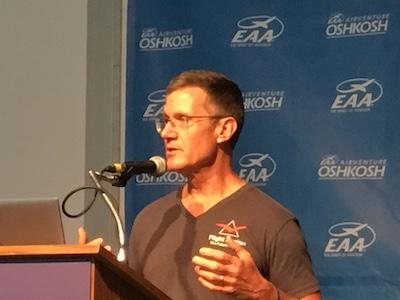Wed, Jul 24, 2019
Four-seat Rotax Airplane Is In Detailed Designing Phase
By: Gary Risley
Flight Design announced at its press conference held at EAA AirVenture Oshkosh Wisconsin, flight design made several announcements Tuesday. The company is currently producing four aircraft per month at their facilities in Germany and Ukraine, and its EASA certified CTLS is now being delivered in Europe. The company is incorporating its “Vision Zero” safety features in all their future aircraft. The Vision Zero concept of Flight Design is designed to make the safest aircraft possible by incorporating advanced safety features with the goal of zero casualties in the event of an emergency landing or other situation.

The F2 is now completing SLSA flight testing. It is a pre-impregnated carbon composite airframe aircraft, and it meets the ASTM F-3180 low-speed standard. It features a cabin that is 53 inches wide, incorporates structure mounted airbags in the panel, and well sport a Garmin avionics package. The aircraft will be powered by a Rotax 912iS or 919iS engine, and there is a Siemens electric model in the works as well. A ballistic parachute is incorporated into the airframe.
The electric version of the F2, known as the F2e, is anticipated to be used for the flight training and personal recreation markets. Due to the weight of the batteries, it is anticipated that the F2e will have a airframe is closer to the size of the F4 (2,200 pounds MTOW), which will allow for batteries to provide a three hour plus endurance. The goal of the companies to have a 2 to 2 ½ hour flight time available for each charge. With further advancement battery technology, it is anticipated that the flight time may be extended further.

The F4 aircraft is in the detailed design phase. The F4 will be a four-seat, three-door aircraft. It will be powered by 141 hp Road tax 915iS engine. The avionics suite will be the Garmin G3 X system, and the airframe will contain a BRS ballistic parachute system. AMSAFE airbags and harnesses will be part of the overall safety system. It is anticipated that the aircraft will be presented at AERO 2020.
(Images provided by author and from Flight Design provided video)
FMI: www.flightdesign.com
More News
Aero Linx: Model Aeronautical Association of Australia MAAA clubs are about fun flying, camaraderie and community. For over 75 years, the MAAA has been Australia’s largest fl>[...]
Touchdown Zone Lighting Two rows of transverse light bars located symmetrically about the runway centerline normally at 100 foot intervals. The basic system extends 3,000 feet alon>[...]
“Discovery and innovation are central to our mission at Virgin Galactic. We’re excited to build on our successful record of facilitating scientific experiments in subor>[...]
How To Get A Story On Aero-TV News/Feature Programming How do I submit a story idea or lead to Aero-TV? If you would like to submit a story idea or lead, please contact Jim Campbel>[...]
Student Pilot Reported That During Rotation, “All Of A Sudden The Back Of The Plane Kicked To The Right..." Analysis: The student pilot reported that during rotation, “>[...]
 ANN's Daily Aero-Linx (05.02.24)
ANN's Daily Aero-Linx (05.02.24) ANN's Daily Aero-Term (05.02.24): Touchdown Zone Lighting
ANN's Daily Aero-Term (05.02.24): Touchdown Zone Lighting Aero-News: Quote of the Day (05.02.24)
Aero-News: Quote of the Day (05.02.24) ANN FAQ: Contributing To Aero-TV
ANN FAQ: Contributing To Aero-TV NTSB Final Report: Cirrus Design Corp SR20
NTSB Final Report: Cirrus Design Corp SR20




